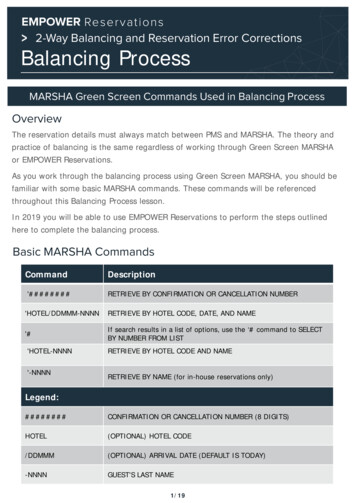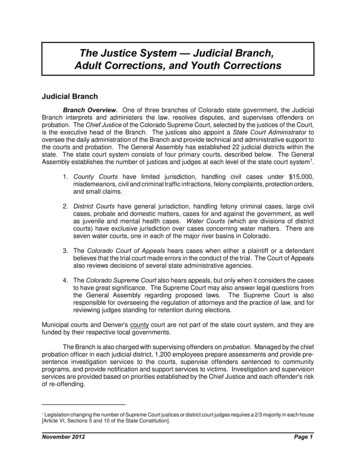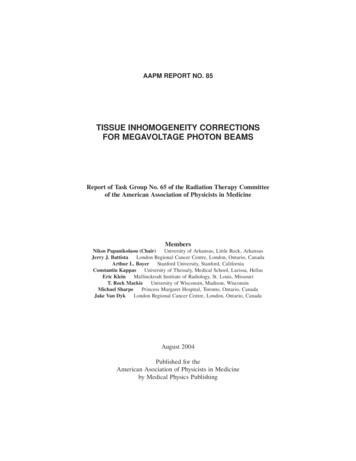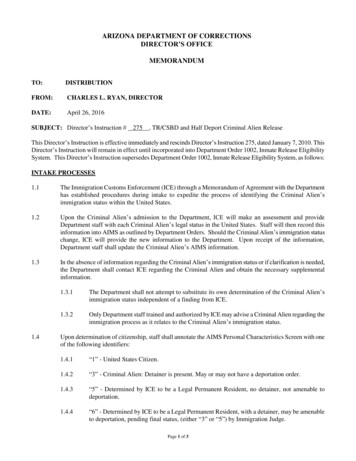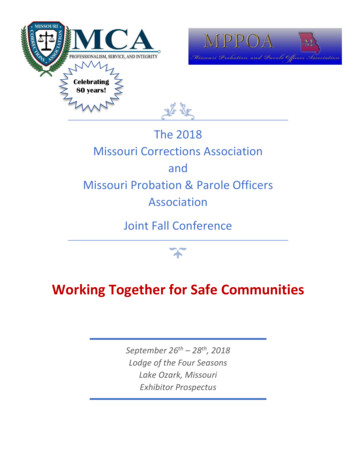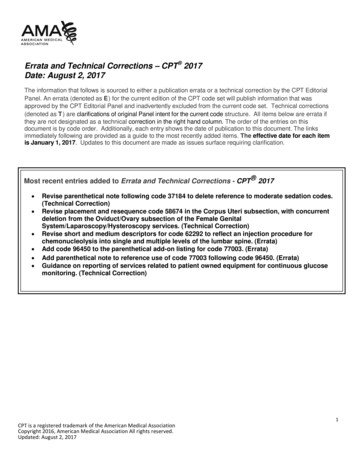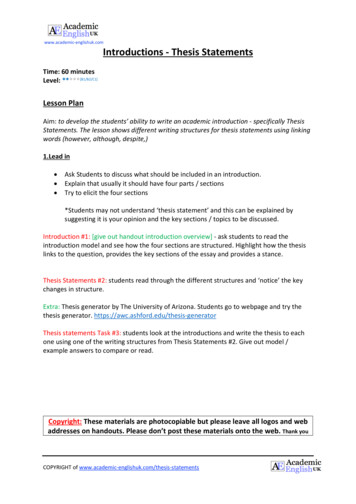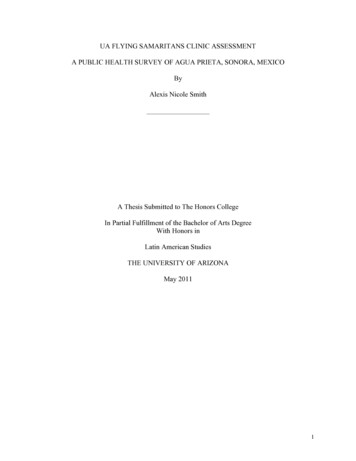
Transcription
UA FLYING SAMARITANS CLINIC ASSESSMENTA PUBLIC HEALTH SURVEY OF AGUA PRIETA, SONORA, MEXICOByAlexis Nicole SmithA Thesis Submitted to The Honors CollegeIn Partial Fulfillment of the Bachelor of Arts DegreeWith Honors inLatin American StudiesTHE UNIVERSITY OF ARIZONAMay 20111
UA FLYING SAMARITANS CLINIC ASSESSMENTA PUBLIC HEALTH SURVEY OF AGUA PRIETA, SONORA, MEXICOByAlexis Nicole SmithA Thesis Submitted to The Honors CollegeIn Partial Fulfillment of the Bachelor of Arts DegreeWith Honor inLatin American StudiesTHE UNIVERSITY OF ARIZONAMay 2011Approved by:Cecilia Ballesteros Rosales, MD, MSAssociate Professor of the Community, Environmental and Policy DivisionMel and Enid Zuckerman College of Public Health
TABLE OF CONTENTSABSTRACT . 6INTRODUCTION . .7Healthcare Across the US Mexico Border . .7Metabolic Syndrome and Its Complications Across the US Mexico Border .9UA Flying Samaritans Clinics . 11Hypothesis .12Objectives of Study .13MATERIALS AND METHODS .14Introduction 14Study Population 14Sample Size and Study Design .14Subject Consent .15Inclusion/Exclusion Criteria .16Data Management and Statistical Method .16Questionnaires, Consent Forms, and Focus Group Questions . .17RESULTS . .18Part I: Retrospective Chart Analysis .18Chief Complaints of Patients with Correspondence to Age .19Chief Complaints with Correspondence to PatientMedical History of Diabetes and Hypertension .21Patient Medication Information .25Part II: Focus Group Discussion Topics . .28Basic Demographics .284
Utilization of Resources . . 29Barriers to Access to Quality Healthcare .29Nutrition .30Residency Inventory . 31Selection of UA Flying Samaritans Clinic and Patient Satisfaction .32DISCUSSION . .34Introduction 34Access to Healthcare Service . . .34Treatment of Disease .35Strengths of Study . .36Limitations of Study .37Conclusions . .38APPENDIX . .40REFERENCES . .595
ABSTRACTUnder the auspices of the Tucson Chapter of Flying Samaritans, the undergraduate studentsof the UA Flying Samaritans club organize, manage, and run a free monthly medical clinic inAgua Prieta, Sonora, Mexico. At these clinics, students take patient history and vitals, work inthe pharmacy, teach health education lessons, and interpret for doctors. The clinics take place atthe Nueva Esperanza community center, available for their use through Frontera de Cristo, anon-profit ministry based out of Douglas. Additionally, the UA Flying Samaritans work inpartnership with Naco Wellness, a non-profit healthcare organization based in Bisbee, Arizona.The objective of this study is to assess the effectiveness of the UA Flying Samaritans freemonthly, student-run clinics in addressing the chief health complaints of patients from the AguaPrieta community. Effectiveness is defined as the value added in providing individual patientcare, overall flow of the clinics, and cultural competence of the staff.Methods of the investigation included collecting epidemiological data from patientsthrough a retrospective chart review (September 2008 – August 2010). This review addressedchief complaints, patient histories, and medications prescribed and previously taken by patients.Furthermore, 3 focus groups of 7-8 patients met in January 2011 and provided additional dataabout patient demographics, and cultural and physical barriers preventing patients from attainingquality healthcare.The results of this study indicate that patient satisfaction rates are very high for the UAFlying Samaritans clinics in terms of medications provided, the competence of the medical staff,and their overall clinical experiences. The focus groups, retrospective patient chart statistics, andphysicians indicate that there is a high demand in the area for treatment of non-communicablechronic diseases, pain, dermatology issues, and other health complications requiring specialists.6
INTRODUCTIONHealthcare Across the U.S.-Mexico BorderExtending 1969 miles in length, according to the International Boundary and Watercommission, the United States-Mexico border is a complex region in terms of social issues andculture (Ruiz-Beltran, 2001). Approximately 11.5 million people live along the U.S-Mexicoborder, and 86% of those people reside in 14 pairs of “sister cities,” metropolitan areas dividedby the international border (Homedes, 2003).Many people travel back and forth, both documented and undocumented, to work,purchase goods and services, and visit family. This high traffic has increased prosperity incertain regions of the border, however, many residents continue to live in poverty. According tothe U.S. Environmental Protection Agency, more than 1 in 10 people living in the Mexico bordercities do not have access to clean water. Hepititis A seropositivity is two and three times higherthan the national rate in the U.S. and Mexico respectively (Homedes, 2003). The immunizationrates are low, while the rates of tuberculosis and gastrointestinal disease are high (McCarthy,2000).On the US side of the border, the population is primarily poor and of Hispanic origin.Thirty five percent of the population lives below the poverty level (Homedes, 2003). The town ofDouglas, Arizona has a population of around 20,000 and the per capita income of Douglas,Arizona was estimated at 10,232 (U.S. Census Bureau, 2010).In the U.S, Medicare and Medicaid are the two primary government health careprograms, insuring about 25% of the population. The private sector finances the majority of thehealthcare system, and the U.S. Military insures about 3.5 %. It was estimated in 2005 that7
approximately 16 percent of the population, 47 million Americans, lacked health insurance alltogether (U.S Census Bureau, 2005). The Hispanic population had a much higher chance ofbeing uninsured than the white population (Ruiz-Beltran, 2001).Of the many socio-economic groups in the U.S, undocumented residents face some of themost severe systemic societal oppression. In terms of healthcare, many undocumented residentsdo not seek out services due to fear of deportation and discrimination. In the absence of illness,many undocumented people and uninsured documented individuals do not utilize U.S resourcesdevoted to healthcare. However, limited access to routine healthcare services causes a higherlikelihood for these individuals to develop more serious conditions requiring high costemergency medical care.On the Mexican side of the border, much of the population is more affluent incomparison to the general population of Mexico. In 2005, Agua Prieta had a population of68,402 people and a literacy rate of 96.3%. 89% of the homes in the city had electricity, 94% hadrunning water, and 86% were connected to the sewer system. The city's most importanteconomic activities were industry, commerce, and farming. The population is estimated atapproximately 70,303 residents (INEGI, 2005).There is still limited access to healthcare in Mexico for many of its residents. TheMexican government has attempted to provide access to healthcare for all of its citizens throughthe Secretaria de Salud (Ministry of Health). Additionally, the Instituto Mexicano del SeguroSocial (Social Security) covers 46% of the population, the Instituto de Seguridad Social para losTrabajadores del Estado (state employee social security system) covers about 20% of thepopulation, and smaller systems cover about 4% of the population. Such smaller systems includeSEDENA (Armed Forces) and PEMEX (Oil Industry). Despite the existence of these services,8
many Mexican citizens, particularly indigenous people, have little access to healthcare. In 1997,eight to ten percent of the population had no access to healthcare, at all. About one third of thepopulation purchased private healthcare services to supplement the public services, but only2.4% of the population carried private health insurance (Ruiz-Beltran, 2001).Metabolic Syndrome and Its Complications Across the US Mexico BorderSome developing health problems along the US Mexico border include obesity, type IIdiabetes, and high blood pressure. These are all either components or risks factors associatedwith metabolic syndrome. Metabolic syndrome is defined by the American Medical Associationas having at least any three of the five following measurements:a. Abdominal (waist) circumference greater than 40 inches for men or 35 inches for womenb. High blood pressure (hypertension)c. Hyperglycemia (fasting blood sugar more than 110 mg/dL)d. Elevated triglycerides (a type of fat in the bloodstream)e. Low levels of high-density lipoprotein, also known as HDL or “good cholesterol”Individuals with metabolic syndrome are at high risk for developing type II diabetes, coronaryheart disease, heart attack, or stroke. Treatment and prevention of metabolic syndrome includeweight loss, regular exercise, stopping smoking, and reduced dietary fat intake (Torpy, 2006).Although the U.S. has made some great efforts to minimize smoking through mediacampaigns, 30% of Latino teens smoke on the U.S. side of the border. Many of these teens reportbeing influenced by peers, family, and their Latino culture (Chalela, 2007). In a study thatfocused on the impact of the California Control program across the border, there were9
significantly lower rates of smoking in Tijuana than Guadalajara, indicating that distance fromthe United States is directly related to prevalence of smoking habits (Martinez- Donate, 2008).Smoking rates among adults both near the border and further south in Mexico have decreased inthe last 40 years, however, it is still a very prevalent risk factor contributing to the developmentof metabolic syndrome.Globalization has contributed to a transition related to food consumption in Mexico andalong the U.S.-Mexico border, increasing the risk for the development of metabolic syndrome.Dietary intake has transitioned from that of traditional crops to energy-dense processed foodswith higher fat and refined carbohydrate content. Nationally, from 1988 to 1999, the percentageof total energy from fat increased from 23.5 percent to 30.3 percent (Rivera, 2004).The more urbanized and wealthier regions in the north have an even larger increase indietary fat intake than the poorer southern regions. Food purchases of refined carbohydrates andsoda increased by 6.3 percent and 37.2 percent, respectively, in 1998 relative to 1984. This is duein part to an increase in economic interdependence between the U.S. and Mexico following theNAFTA agreement. Consequently, there has been a shift in Mexico in prevalence of diseasefrom under-nutrition to the aforementioned complications related to metabolic syndrome viaobesity (Rivera, 2004).The risk of obesity associated with socioeconomic status is unclear. In Mexico, one studyfound that the prevalence of obesity is higher in more-educated women than less educatedwomen (Martorell, 1998). Conversely, a national health survey conducted in 2000 found that associoeconomic status increases, the sum of overweight and obese people decreases (McCarthy,2000). During the recent economic recession, more and more people are falling below thepoverty line and may be at higher risk for developing obesity and metabolic syndrome.10
Recent increasing awareness of the importance of exercise and other healthy behaviorshas decreased the severity of the impact of globalization on the development of obesity, but thepercentages of obese people are increasing on both sides of the border. Specifically, in the U.S.the Child Nutrition and WIC Re-authorization Act of 2004 required that all school districts witha federally funded school meal program develop wellness policies that address nutrition andphysical activity (Pangrazi, 2006). In Mexico, on July 2, 2010, the lower house of Congressapproved two reform measures banning the sale of junk food in schools and making physicaleducation classes mandatory. They made the decision based of the statistics of the 2006 NationalHealth Survey indicating that 70% of adults and children ages 5-11 years old are overweight.Forty percent (40%) of Mexicans are obese (Hearld Tribune, 2010). Although these effortsdecrease the risk factors related to developing obesity and metabolic syndrome, rates of diseasehave continued to rise due to other sedentary lifestyle factors (Ghaddar, 2010).UA Flying Samaritans ClinicsFlying Samaritans Arizona is a volunteer-based, nonsectarian organization dedicated toproviding free medical care to residents in remote, underserved regions of Mexico who areunable to access medical services. To accomplish this mission, organization activities mayinclude but are not limited to: Establish and operate clinics to provide medical care at no cost in Mexicancommunities. Recruit volunteers who wish to join the organization as members and participate inthe organization’s activities or support the mission. Raise funds to establish and operate clinical facilities and procure (andmaintain/replenish) medical equipment and supplies for those facilities.11
Partner with health care programs at universities, allowing participation of studentsand graduates at Flying Samaritans Arizona clinics as part of their training andcommunity service.Under the auspices of the Tucson Chapter of Flying Samaritans Arizona, theundergraduate students of the UA Flying Samaritans club organize, manage, and run a monthlyfree medical clinic in Agua Prieta, Sonora, Mexico. At these clinics, students take patient historyand vitals, work in the pharmacy, teach health education lessons, and interpret for doctors. Theclinics take place at the Nueva Esperanza community center, available for their use throughFrontera de Cristo, a non-profit ministry-based located in Douglas. Additionally, UA FlyingSamaritans works in a partnership with the organization Naco Wellness, which is based inBisbee, Arizona (Bylaws, 2010).The club currently has 425 patient records. The files are stored in a locked drawer at theUniversity of Arizona in between clinic dates. The patient records include reason for visit, familymedical history, patient medical history, allergies, current medications, chronic conditions,diagnosis, and medications prescribed by the volunteer physicians and medical staff.HypothesisThe retrospective patient chart review and focus groups will reveal a high prevalence ofconditions related to metabolic syndrome in patients (ie diabetes, hypertension, and renaldisease), which most likely results from a nutritional transition caused by the impact ofglobalization.12
Objectives and Aims of StudyThe objective of this study is to assess the effectiveness of the UA Flying Samaritans freemonthly, student-run clinics in addressing the chief health complaints of patients from the AguaPrieta community. Effectiveness includes individual patient care, overall flow of the clinics, andcultural competence of the staff. Intended outcomes of this study include providing the UAFlying Samaritans club, physicians, and other medical service organizations working in the areawith some useful epidemiological trends to most effectively address the needs of patients fromthe Agua Prieta community.This study is significant because it directly evaluates the effectiveness of the UA FlyingSamaritans clinics. The results of this study can be used by interested individuals and otherorganizations involved with the Community Center Nueva Esperanza to improve the health andsocial services that they provide to the municipality of Agua Prieta. These organizations include,but are not limited to Frontera de Cristo Presbyterian Ministry, Naco Wellness Initiative,Community Center administrators, DIF, the General Hospital, and community leaders of AguaPrieta.13
MATERIALS AND METHODSIntroductionThis study was approved by the Office for Human Subjects Protection at the Universityof Arizona. The PI and all co-investigators and research assistants were trained and certified toparticipate and conduct this study. A total of 425 patient records were compiled to assessepidemiological trends. The patient records consisted of information pertaining to medicalhistory, vitals results, current medications, family illnesses, chief complaints, and medicationsprescribed. Additionally, three focus groups, each with seven or eight consented patients fromour clinics, were brought together to discuss the education level, resource availability, migrationinformation, residency information, nutrition, and other factors pertaining to the patients andtheir access to healthcare. The collection of data was supported by Frontera de Cristo, theCommunity Center Nueva Esperanza, and the community of Agua Prieta. No outside fundingwas necessary for the completion of this project.Study PopulationThe targeted study participants were Spanish-speaking residents of the border communityof Agua Prieta, Sonora. The estimated total population of Agua Prieta in 2005 was 70,303permanent residents, according to the Instituto Nacional de Estadística, Geografía e Información(INEGI, 2005). All focus group participants were adults, 18 years of age or older. The focusgroups consisted of both men and women. Individuals eligible to participate must have attendedat least one UA Flying Samaritans clinic. Participants were randomly selected, allowing for adiverse sample, representative of the clinic patients.14
Sample Size and Study DesignNo recruitment was done for the retrospective medical chart study. All available chartsfor Flying Samaritans patients who have been treated by the UA Flying Samaritans clinics inAgua Prieta, Sonora were reviewed regardless of patient age, gender, or other characteristics.The study population consisted of patients who are residents of Agua Prieta Mexico. Twenty-twopatients older than 18 years of age, not incarcerated, and who had been treated at the UA FlyingSamaritans clinics were recruited to participate in three focus groups in January 2011. Patientswere recruited regardless of race, ethnicity, or gender.Subject ConsentThe patient records of the clinics from September 2008 to August 2010 provided themajority of the data for the study. The 22 participants were recruited during the fall clinics by thePI and epidemiological committee to participate in one of three focus groups for one hour onFebruary 26, 2011. The record data was anonymized and the records were locked up in a safeplace except during the clinics. The focus group participant information was kept with therecords. All patient contact information remains with the records.For the retrospective medical chart review, a waiver of consent was used (Yaman et. al,2011). It would have been too difficult to obtain consent for each patient whose chart wasreviewed given that the population in this border region is highly mobile, not all may havecurrent permanent contact information, and some of the charts reviewed dated back 2 years.Personal identifiers were not used in the chart review, so there was minimal risk to patientswhose medical records were reviewed. For the focus group interviews, written consent forparticipation was obtained.15
Written consent forms were provided in English or Spanish depending on participantp
the Nueva Esperanza community center, available for their use through Frontera de Cristo, a non-profit ministry based out of Douglas. Additionally, the UA Flying Samaritans work in partnership with Naco Wellness, a non

